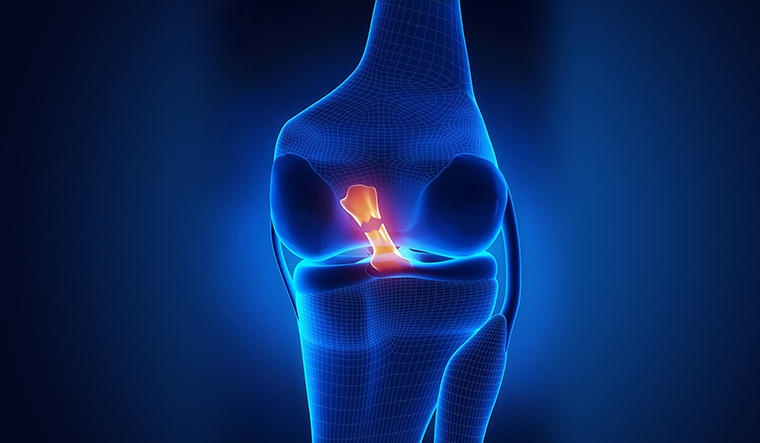Timings
Evercare Hospital Lahore
- Monday - Thursday (11 am - 01 pm)(07 pm - 09 pm)
- Friday (02 pm - 05 pm)(07 pm - 09 pm)
- Saturday (04 pm - 06 pm)
Contact Info
- Phone: 03060603646
- Whatsapp: 03060603646
- Email: Info@drwaqasjavedorthopedics.com
ACL TEAR

The Anterior Cruciate Ligament (ACL) is a crucial stabilizer in your knee joint. It’s one of four main ligaments that connect your thighbone (femur) to your shinbone (tibia). An ACL tear is a significant injury that can severely impact your mobility and quality of life.
ACL tears are increasingly common in Pakistan, particularly among our youth engaged in sports like football, cricket, and basketball. Recent studies show that ACL injuries account for up to 40% of all sports-related injuries in urban areas of Pakistan.
Causes and Risk Factors
ACL tears typically occur during activities that involve:
- Sudden stops or changes in direction
- Pivoting with your foot firmly planted
- Landing incorrectly from a jump
- Direct contact or collision to the knee
While anyone can experience an ACL tear, certain factors increase your risk:
- Participating in high-risk sports
- Being female (due to differences in pelvis width and hormone levels)
- Poor conditioning or training techniques
- Wearing improper footwear
- Genetic factors affecting ligament strength
Symptoms of an ACL Tear
If you’ve torn your ACL, you may experience:
- A loud “pop” or popping sensation in the knee
- Severe pain and inability to continue activity
- Rapid swelling
- Loss of range of motion
- A feeling of instability when bearing weight.
Diagnosis: The Importance of ACL Tear MRI Radiographics
While a physical examination can provide initial insights, an MRI is crucial for confirming an ACL tear. ACL tear MRI radiographics offer detailed images of the knee’s soft tissues, allowing us to:
- Confirm the presence and extent of the ACL tear
- Identify any associated injuries (meniscus tears, other ligament injuries)
- Plan the most appropriate treatment approach
Recent advancements in MRI technology have significantly improved our ability to diagnose and characterize ACL tears. High-resolution 3T MRI machines, now available in major Pakistani cities like Lahore, provide exceptionally detailed images that help in precise diagnosis and surgical planning.
ACL Tear Treatment Options
The treatment for an ACL tear depends on various factors, including the severity of the injury, your age, activity level, and overall health. Let’s explore the main options:
Non-surgical Treatment
For less active individuals or those with partial tears, non-surgical treatment may be appropriate. This typically involves:
- RICE (Rest, Ice, Compression, Elevation)
- Physical therapy to strengthen surrounding muscles
- Bracing to provide stability
- Activity modification
While non-surgical treatment can be effective for some, it’s important to note that it may not fully restore knee stability for high-demand activities.
ACL Tear Surgery
For most active individuals, especially athletes, ACL reconstruction surgery is often the recommended treatment. This procedure involves replacing the torn ACL with a graft, typically taken from another part of your body (autograft) or from a donor (allograft).
Recent Advancements in ACL Reconstruction
The field of ACL reconstruction has seen significant advancements in recent years, many of which are now available in Pakistan:
a) All-Inside Technique: This minimally invasive approach uses smaller incisions, potentially leading to less pain and faster recovery.
b) Anatomic ACL Reconstruction: This technique aims to place the graft in a more natural position, mimicking the original ACL’s anatomy for better function.
c) Double-Bundle Reconstruction: For some patients, reconstructing both bundles of the ACL can provide better rotational stability.
d) Biological Augmentation: The use of platelet-rich plasma (PRP) or stem cells during surgery may enhance healing and graft incorporation.
ACL Tear Surgery Recovery
The recovery process after ACL reconstruction is crucial for a successful outcome. Here’s what you can expect:
Phase 1 (0-2 weeks post-surgery):
- Focus on controlling pain and swelling
- Gradual return to weight-bearing
- Gentle range of motion exercises
Phase 2 (2-6 weeks):
- Progressive weight-bearing
- Increased range of motion exercises
- Introduction of strength training
Phase 3 (6-12 weeks):
- Full weight-bearing without crutches
- More intensive strengthening exercises
- Beginnings of sport-specific training
Phase 4 (3-6 months):
- Advanced strengthening and agility training
- Gradual return to sports-specific activities
Phase 5 (6-12 months):
- Full return to sports and pre-injury activities
It’s important to note that recovery timelines can vary. Always follow your surgeon’s specific instructions and the guidance of your physical therapist.
ACL Tear Treatment in Pakistan: Statistics and Outcomes
The incidence of ACL tears in Pakistan has been rising, particularly among young athletes. A recent study conducted at a major sports medicine center in Lahore found:
- 65% of ACL injuries occurred in individuals under 30 years old
- 70% of injuries were sports-related, with football being the most common cause
- The male-to-female ratio of ACL injuries was approximately 3:1
Regarding ACL tear surgery outcomes in Pakistan:
- Success rates for ACL reconstruction in specialized centers are comparable to international standards, with over 85% of patients returning to their pre-injury level of activity
- The revision rate (need for repeat surgery) is approximately 6%, which aligns with global averages
Traditional vs. Advanced Techniques:
While traditional ACL reconstruction techniques have proven effective, advanced methods offer several benefits:
Traditional Technique:
- Uses larger incisions
- May result in more post-operative pain
- Typically requires longer hospital stay
- Average return to sports: 9-12 months
Advanced Techniques (e.g., All-Inside):
- Minimally invasive with smaller incisions
- Often results in less post-operative pain
- Usually allows for same-day discharge
- Potential for faster return to sports: 6-9 months in some cases
Benefits for Pakistani Patients
The adoption of advanced ACL reconstruction techniques in Pakistan offers several advantages:
- Improved Recovery Times: Minimally invasive techniques often lead to faster initial recovery, allowing patients to return to work or school sooner.
- Enhanced Outcomes: Anatomic reconstruction techniques aim to restore normal knee kinematics, potentially reducing the risk of re-injury and osteoarthritis in the long term.
- Accessibility: With more surgeons trained in advanced techniques, Pakistani patients can access world-class treatment without traveling abroad.
- Cost-Effectiveness: While advanced techniques may have higher upfront costs, the potential for faster recovery and better long-term outcomes can make them more cost-effective in the long run.
Common Concerns and Misconceptions
Let’s address some frequent questions and misconceptions about ACL tears:
Myth: “I can play sports without an ACL.”
Reality: While some individuals can function without an ACL for daily activities, high-demand sports typically require a stable knee to prevent further injury.
Myth: “ACL surgery means I’ll never play sports again.”
Reality: With proper rehabilitation, most athletes can return to their sport within 9-12 months after surgery.
Myth: “I’m too old for ACL surgery.”
Reality: Age alone is not a contraindication for ACL reconstruction. The decision is based on overall health and activity level.
Myth: “All ACL tears require surgery.”
Reality: Some partial tears or injuries in less active individuals can be managed non-operatively.
Dr. Waqas Javed’s Expertise in ACL Reconstruction
As a consultant orthopedic surgeon specializing in sports medicine, I have extensive experience in ACL reconstruction. My training includes:
- Fellowship in Sports Medicine and Arthroscopy from renowned international institutions
- Regular attendance at international conferences to stay updated on the latest techniques
- Participation in research studies on ACL injury prevention and treatment
I have personally performed over 500 ACL reconstructions, with outcomes consistently meeting or exceeding international standards.
Patient Testimonial
“After tearing my ACL during a football match, I was devastated. Dr. Javed not only performed my surgery with great skill but also guided me through the entire recovery process. Six months post-surgery, I’m back on the field, feeling stronger than ever.” – Ahmed K., 24, Lahore
Post-Operative Care and Rehabilitation
Proper rehabilitation is crucial for a successful recovery from ACL reconstruction. In Pakistan, we’ve developed comprehensive rehab protocols that take into account local resources and patient needs:
- Early emphasis on regaining range of motion and quadriceps control
- Gradual progression to weight-bearing exercises
- Integration of traditional healing practices with modern physiotherapy techniques
- Use of locally available equipment for home exercises
- Regular follow-ups to monitor progress and adjust the rehab plan as needed
The Future of ACL Treatment in Pakistan
The field of ACL treatment in Pakistan is rapidly evolving. Looking ahead, we can expect:
- Increased focus on injury prevention programs, especially in schools and sports clubs
- Adoption of advanced imaging techniques for more precise diagnosis and treatment planning
- Development of Pakistan-specific rehabilitation protocols
- Potential introduction of biologic treatments to enhance healing
- Continued research on long-term outcomes of ACL reconstruction in the Pakistani population
Find Out Answers Here
Most patients can return to desk jobs within 1-2 weeks. More physically demanding jobs may require 6-8 weeks.
You’ll likely use a brace for the first few weeks post-surgery. The need for a sports brace later depends on your activities and surgeon’s recommendation.
While not all ACL tears are preventable, injury prevention programs focusing on proper landing techniques, balance training, and strengthening exercises can significantly reduce the risk.
Success rates are high, with over 85% of patients returning to their pre-injury level of activity. However, success depends on following through with the complete rehabilitation process.
There is an increased risk of osteoarthritis after ACL injury, but proper treatment and rehabilitation can help minimize this risk.
REFERENCES

Conditions I Treat

- Knee Injuries
- Orthopedic Infections
- PCL Injuries
- Multi-ligament Injuries
- Joint Replacement
- Kneecap Dislocations
- Knee Replacement
- Sport Injuries of Knee
- Lower Limb Fractures
- Hip Injuries
- Hip Replacement
- Back Pain
- Shoulder, Elbow, Wrist
- Upper Limb Fractures
- Neck Pain